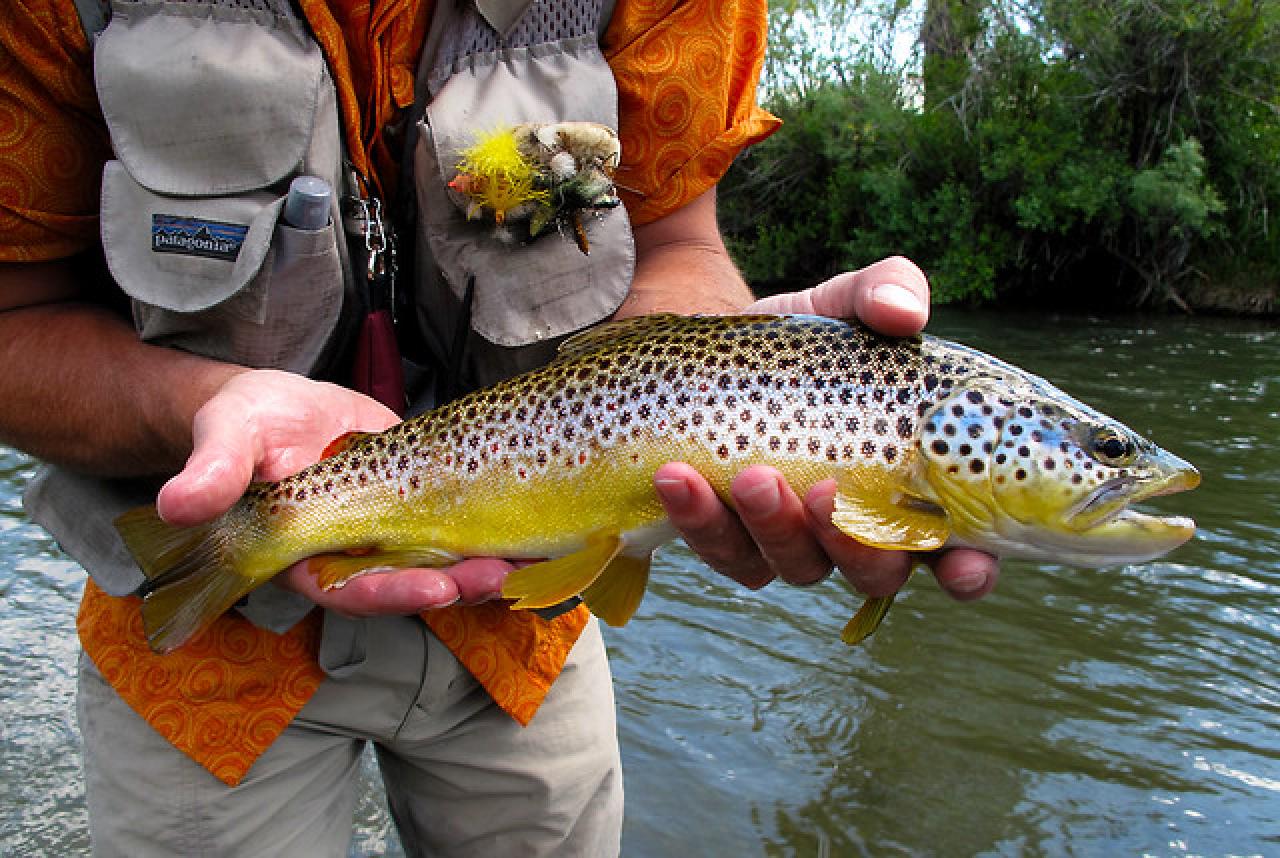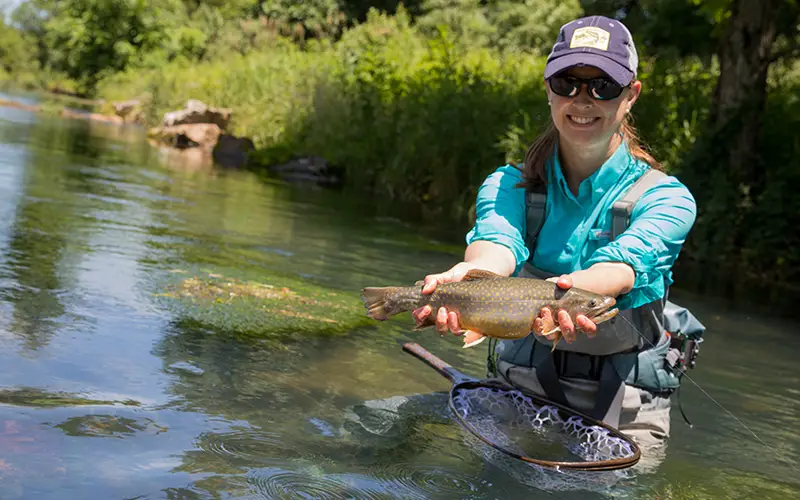Trout usually live in cool freshwater, often among submerged objects or in riffles and deep pools native to the Northern Hemisphere but have been widely introduced to other areas around the globe. What Are Ideal Water Conditions for Trout?
Ideal water conditions for Trout include:
- Water temperature: Trout prefer cool H2O temperatures between 50°F (10°C) and 65°F (18°C).
- Dissolved oxygen: well-oxygenated (DO) over 7.0 to 12 ppm
- Stable pH: 6.5-7.5
- Clear, clean water
- Minimal pollutants
- Adequate flow
- Varied habitat structure
- Shelter availability
Introduction:
Trout, revered by anglers worldwide, are prized for their beauty, fighting spirit, and delicious taste. They inhabit freshwater streams, rivers, lakes, and ponds, captivating anglers with their elusive nature and challenging behavior. Understanding the habitat preferences of trout is essential for successful fishing and conservation efforts. Trout are sensitive to changes in their environment, and their abundance and distribution are closely linked to specific habitat characteristics.
What Are Ideal Water Conditions for Trout
By comprehending their habitat requirements, anglers and conservationists can work together to protect and preserve trout populations for future generations. Water quality parameters such as temperature, dissolved oxygen levels, and pH play a critical role in determining the health and suitability of trout habitats. These factors directly influence trout behavior, growth, reproduction, and overall survival. Therefore, focusing on these parameters is vital for maintaining optimal conditions in trout habitats and ensuring thriving populations.
Ideal water conditions for trout include temperatures between 50-60°F, dissolved oxygen levels above 7 ppm, and a pH around 6.5-7.5. Clean water free of pollutants, with adequate flow and varied habitat structure, is crucial for their survival and reproduction. Providing ample shelter opportunities further enhances their ability to thrive in their aquatic environment.
Ideal Water Temperature for Trout
Ideal Temperature Range for Trout Habitat:
- Trout thrive in cool water environments, typically preferring temperatures between 50°F (10°C) and 65°F (18°C).
- Within this range, different species of trout may have specific temperature preferences based on their evolutionary adaptations and habitat requirements.
- Coldwater streams and rivers with stable temperature regimes provide ideal habitats for trout populations, supporting their growth, reproduction, and overall health.
Impact of Water Temperature on Trout Behavior and Metabolism:
- Water temperature significantly influences trout behavior, with warmer temperatures often leading to increased activity and metabolism.
- In warmer water, trout may seek out cooler, shaded areas or deeper pools to avoid thermal stress and conserve energy.
- Conversely, colder water temperatures can slow down trout metabolism and reduce their feeding activity, particularly in winter months when temperatures drop.
- Extreme temperature fluctuations can stress trout populations, affecting their growth rates, reproductive success, and overall survival.
Importance of Cool, Well-Oxygenated Water for Trout Survival:
- Cool, well-oxygenated water is essential for maintaining healthy trout populations, as it supports their respiratory functions and metabolic processes.
- Adequate dissolved oxygen levels are crucial for trout survival, as they rely on oxygen-rich water to extract energy from food and sustain their physiological functions.
- Streams and rivers with high oxygen content, typically associated with cooler water temperatures and good water flow, provide optimal habitats for trout.
- Conservation efforts aimed at preserving and restoring cool, well-oxygenated water habitats are essential for ensuring the long-term viability of trout populations and promoting sustainable fisheries management.
Ideal Dissolved Oxygen Levels for Trout
Importance of Dissolved Oxygen for Trout Respiration:
- Dissolved oxygen (DO) is essential for trout respiration, as they extract oxygen from water through their gills to support aerobic metabolism.
- Trout rely on sufficient levels of dissolved oxygen to meet their metabolic demands, including energy production, growth, and maintenance of vital physiological functions.
- Inadequate dissolved oxygen levels can lead to hypoxia (low oxygen) or anoxia (absence of oxygen), causing stress, reduced feeding activity, and even mortality in trout populations.
Optimal Dissolved Oxygen Concentrations for Trout Habitat:
- Trout thrive in habitats with dissolved oxygen concentrations typically above 5 mg/L (milligrams per liter), although optimal levels may vary among species and life stages.
- Higher dissolved oxygen concentrations, ranging from 8 to 12 mg/L, provide ideal conditions for trout growth, reproduction, and overall health.
- Maintaining adequate dissolved oxygen levels is crucial for sustaining healthy trout populations and ensuring their long-term survival in freshwater ecosystems.
Factors Affecting Dissolved Oxygen Levels in Trout Streams:
- Water temperature: Warmer water holds less dissolved oxygen than cooler water, so high temperatures can reduce oxygen availability for trout.
- Turbulence and water flow: Oxygen exchange occurs more efficiently in well-aerated, turbulent water, which can increase dissolved oxygen levels in trout habitats.
- Organic matter decomposition: Decomposition of organic matter, such as leaves and aquatic vegetation, consumes oxygen and may lead to decreased dissolved oxygen levels, especially in stagnant or eutrophic waters.
- Pollution and nutrient runoff: Excess nutrients from agricultural runoff or urban pollution can promote algal blooms, which deplete oxygen levels through increased biological oxygen demand and decomposition processes.
- Seasonal and diurnal variations: Dissolved oxygen levels may fluctuate seasonally or throughout the day due to factors such as photosynthesis, respiration, and thermal stratification in water bodies.
- Understanding these factors and monitoring dissolved oxygen levels is essential for managing trout habitats and mitigating potential stressors to ensure optimal conditions for trout survival and reproduction.
Ideal pH Levels for Trout
Effect of pH on Trout Physiology and Behavior:
- pH levels influence various physiological processes in trout, including respiration, ion regulation, and enzyme activity.
- Extreme pH levels can disrupt acid-base balance in trout, leading to metabolic stress and impaired physiological functions.

pH ranges for Trout - pH fluctuations may affect trout behavior, including feeding activity, habitat selection, and overall stress response.
Preferred pH Range for Trout Habitats:
- Trout typically prefers neutral to slightly acidic pH levels ranging from 6.5 to 7.5.
- Within this range, trout exhibit optimal physiological performance and behavior, including normal growth, reproduction, and resistance to environmental stressors.
- Water bodies with pH levels outside the preferred range may negatively impact trout populations, leading to reduced survival, growth rates, and reproductive success.
Sources of pH Fluctuations in Freshwater Ecosystems:
- Natural processes such as weathering of rocks, soil erosion, and organic matter decomposition can influence pH levels in freshwater ecosystems.
- Human activities such as mining, agriculture, and urban development may contribute to pH fluctuations through the release of acidic or alkaline substances into water bodies.
- Acid rain, resulting from air pollution and industrial emissions, can lower pH levels in surface waters, affecting trout habitats and aquatic biodiversity.
- Biological activities such as photosynthesis, respiration, and nutrient cycling by aquatic plants and algae can also influence pH dynamics in freshwater ecosystems.
- Understanding the sources of pH fluctuations and their effects on trout habitats is essential for effective management and conservation of freshwater resources, ensuring suitable conditions for trout survival and ecosystem health.
Monitoring Trout Habitats for Fishing
Managing Trout Habitats
Strategies for Maintaining Suitable Water Quality for Trout:
- Implement best management practices (BMPs) to reduce pollution and nutrient runoff from agricultural and urban areas, minimizing the risk of water quality degradation in trout habitats.
- Restore riparian vegetation along streambanks to stabilize soil, filter pollutants, and provide shade, which helps regulate water temperature and maintain suitable habitat conditions for trout.
- Monitor and manage water withdrawals and diversions to ensure adequate flow and oxygenation in trout streams, especially during dry periods or in areas with high water demand.

Ideal Waters for big brown trout - Collaborate with local communities, government agencies, and stakeholders to develop watershed management plans that prioritize water quality protection and restoration efforts in trout habitats.
Conservation Efforts to Protect and Enhance Trout Habitats:
- Establish and enforce regulations and policies to protect sensitive trout habitats from harmful activities such as mining, logging, and overdevelopment.
- Conduct habitat restoration projects, including streambank stabilization, habitat enhancement, and invasive species removal, to improve habitat quality and connectivity for trout populations.
- Support land conservation initiatives to preserve critical habitat areas, such as spawning grounds, nursery areas, and migration corridors, for trout and other aquatic species.
- Educate the public about the importance of trout habitat conservation and encourage participation in volunteer monitoring, restoration, and stewardship programs.
Role of Anglers and Conservationists in Preserving Trout Populations:
- Practice catch-and-release fishing techniques to minimize the impact on trout populations, particularly in sensitive habitats or during spawning seasons.
- Follow angling regulations and guidelines to prevent overfishing and ensure sustainable trout populations for future generations.
- Participate in habitat restoration and conservation projects organized by local conservation groups, watershed associations, or government agencies.
- Advocate for policies and initiatives that prioritize habitat protection, water quality improvement, and sustainable management practices to safeguard trout populations and their habitats.
- By working together, anglers and conservationists can play a significant role in preserving trout populations and maintaining healthy freshwater ecosystems for the benefit of both people and wildlife.
Conclusion:
Trout exhibit distinct preferences for water quality parameters crucial to their survival and well-being. They thrive in cool water environments, typically favoring temperatures between 50°F and 65°F, which provide optimal conditions for their growth and metabolism. Adequate dissolved oxygen levels are essential for trout respiration, with concentrations ideally above 5 mg/L to support their physiological functions. Additionally, trout habitats are favored in neutral to slightly acidic pH levels ranging from 6.5 to 7.5, ensuring suitable conditions for their health and behavior. Understanding and maintaining these water quality parameters are vital for sustaining healthy trout populations and preserving their habitats in freshwater ecosystems.
References:

Wild Trout Trust- Trout Facts
Brittanica- Trout Species
FAQ’s
- What are the effects of pollutants on trout populations?
Pollutants can harm trout populations by reducing water quality, affecting their reproductive success, growth rates, and overall health. They may also disrupt aquatic ecosystems, leading to declines in prey availability and habitat degradation, further impacting trout populations.
- What types of habitats do trout thrive in?
Trout thrive in habitats characterized by cold, clean, and well-oxygenated water, such as mountain streams, rivers, and lakes with rocky bottoms and abundant vegetation for cover. They prefer areas with riffles, pools, and runs that provide a variety of depths and currents for feeding and shelter.



